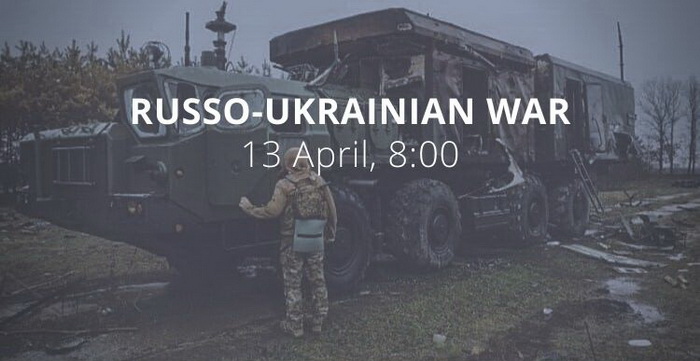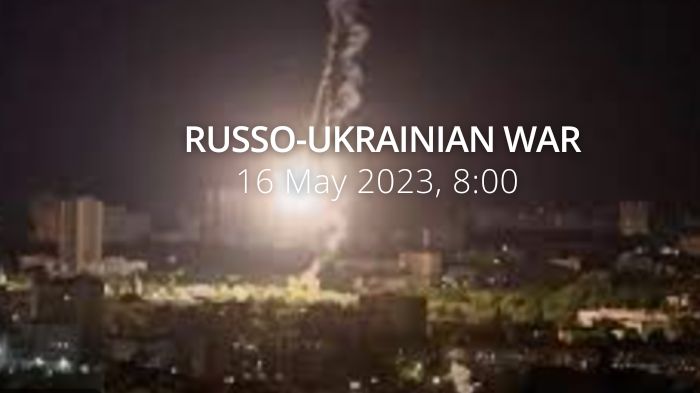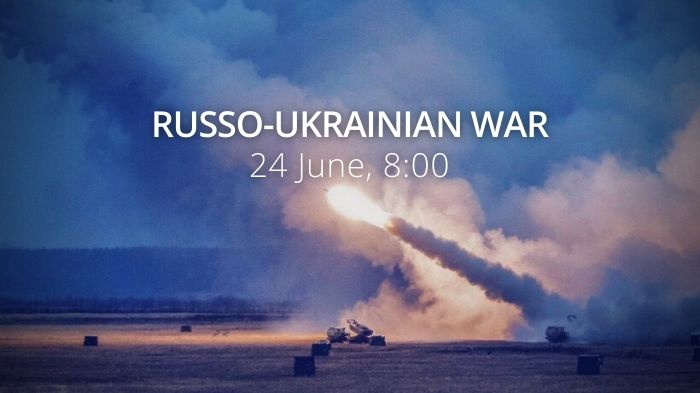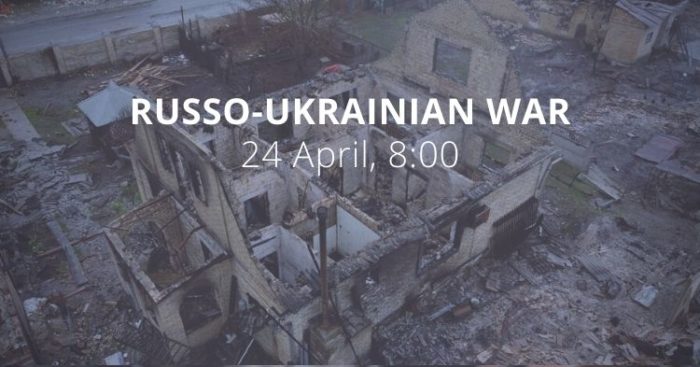The Ukrainian military has repulsed six enemy attacks in the Donetsk and Luhansk Oblasts and destroyed a column of Russian tanks near Kharkiv. The Russian military continued to launch airstrikes on Mariupol, it is launching an offensive near the Azovstal metallurgical complex and the Seaport. Russian forces continue to use artillery and rocket-propelled grenade launchers to destroy the residential areas of Kharkiv, Dergachi, and Pyatyhatky.
Morning report day 49 – April 13
Situation
According to information from the General Staff,
“The Russian federation continues its full-scale armed aggression against Ukraine.
Russian forces continue to launch missile and bomb strikes on civilian infrastructure in Kharkiv and Zaporizhzhia oblasts. Actively conducts air reconnaissance.
There are a high threat of Russian enemy missile strikes on military and civilian infrastructure throughout Ukraine and the possibility of intensification of the occupation forces to advance to the administrative borders of Donetsk and Luhansk oblasts.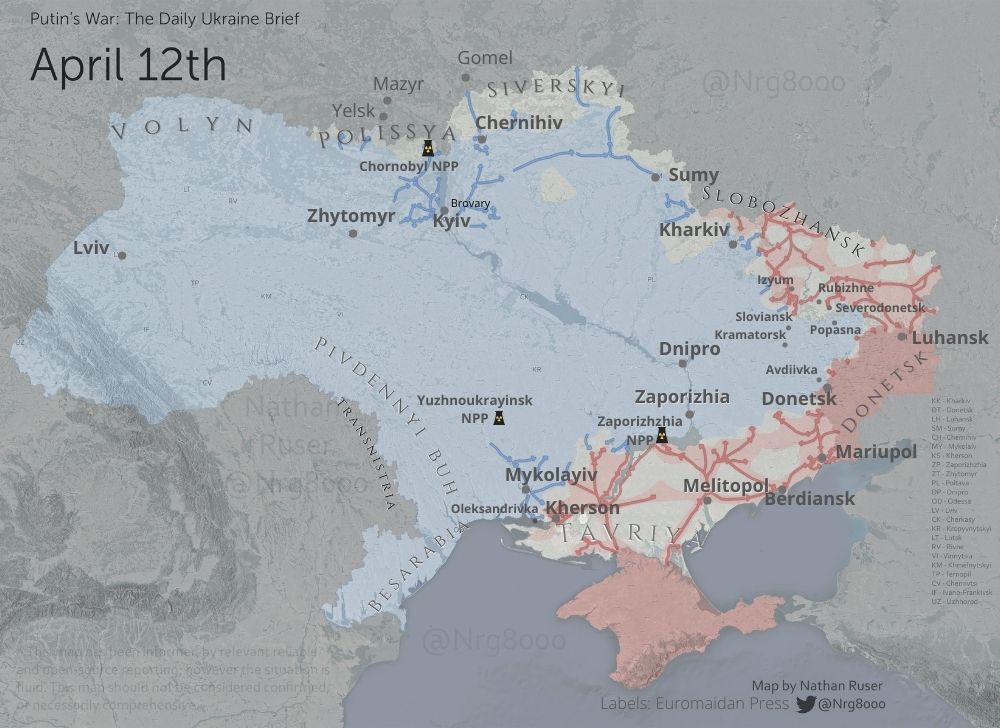
The Russian Federation introduced the so-called "yellow level of terrorist threat" until April 26 in the areas bordering our country and in the temporarily occupied territory of Crimea. These measures are probably carried out in order to organize the movement of military equipment, weapons and personnel on the territory of Ukraine.
In the Volyn and Polissya areas, the situation has not changed significantly.
In the Siversky direction, it is possible to maintain separate units in the border areas of the Kursk region with Ukraine to conduct demonstration actions in order to restrain our forces.
- In the Siversky direction the planned measures of operational and combat training of units of the Armed Forces of the Republic of Belarus are being carried out. Some military units of this country continue to perform tasks to strengthen the Ukrainian-Belarusian section of the state border.
Partial blockade and artillery shelling of the city of Kharkiv continues in the Slobozhansky direction. In some temporarily occupied territories, the enemy resorted to forming units of the so-called "people's militia." Appropriate work carries out to implement these measures.
- Russian forces continue to use artillery and rocket-propelled grenade launchers to destroy the residential areas of Kharkiv, Dergachi and Pyatyhatky.
- Regrouping and relocation of Russian forces to areas of concentration in the Slobozhansky and Donetsk directions continues. The administrative-police regime was strengthened in order to prevent local residents from recording the movement of weapons and military equipment in the border areas of the Kursk, Bryansk and Voronezh regions of the Russian Federation, under the guise of a high level of "terrorist threat".
- The relocation of units of the 41st Combined Arms Army and the 90th Tank Division of the Central Military District to certain districts of the Belgorod and Voronezh regions is nearing completion.
- In the area of the city of Izium, the occupiers regrouped units, replenished supplies and focused on maintaining the pontoon crossing over the Siversky Donets River, and air reconnaissance of the area with the use of unmanned aerial vehicles continues. To strengthen the group, separate units of the 1st Tank Army of the Armed Forces of the Russian Federation were moved to the area.
In the Luhansk direction During the day, the Russian occupiers tried to improve the tactical situation in the areas of Popasna, Stepne, Rubizhne and Nyzhne. They were unsuccessful.
- Engineering units of the armed forces of the Russian Federation are trying to restore the railway bridges in the area of Svatovo.
In the Donetsk and Tavriya directions, the Russian forces continued to launch airstrikes on Mariupol. It is launching an offensive near the Azovstal metallurgical complex and the Seaport.
- Over the past 24hrs, the defenders of Ukraine have repulsed six enemy attacks and destroyed two vehicles and three enemy artillery systems in the Donetsk and Luhansk oblasts.
In the Pivdennyi Buh direction, the enemy is trying to seize individual settlements, but without success.
- Russian forces are trying to hold the occupied territory, conducted air reconnaissance with unmanned aerial vehicles, fired at Mykolayiv and Oleksandrivka from multiple rocket launchers.
A Russian Su-25 was shot down by a group of the Air Force of the Armed Forces of Ukraine the day before. The enemy has significantly reduced the use of aircraft due to weather conditions
.
In the Black and Azov Seas, Russian naval groups continue to carry out tasks to isolate the area of hostilities and reconnaissance.
The defenders of Ukraine inflict losses on the enemy and gradually liberate the occupied territories.“
Ukraine’s Armed Forces liberate more than 15 localities, advance deep into Kherson oblast, Ukrinform reported yesterday. The Ukrainian army pushed the line of fire from Kryvyi Rih district deep into Kherson region, liberating more than 15 populated localities."
In the Kharkiv region, the Ukrainian army destroyed a column of tanks on a ‘tip’ from Russian propagandist, Ukrinform reports. "April 12. A new column of Russian tanks of the 4th Guards Tank Division of Kantemirov, the parade division of the Russian armed forces, entered eastern Ukraine. The column was completely destroyed, and a T-80 became a trophy," Editor-in-chief of the online publication Censor.Net, Yuriy Butusov, said. He noted that recently this column, which was crossing the Siverskyy Donets River in the area of Izium "for a decisive breakthrough," was shown by propagandist Aleksandr Kots.
Russian forces fired phosphorous bombs at the village of Novoyakovlivka in Zaporizhzhia on the night of 12 April, Ukrainska Pravda reports.
Information on chemical weapons in Mariupol is being checked, the Ukrainian Ministry of Defense says according to Ukrainska Pravda. "As of now, we are checking this information, trying to understand what (it was). The final official information will be later", Deputy Minister of Defense, Anna Maliar, said. She stressed that the risk of using chemical weapons by Russia exists and it is quite high. The United States, Britain and other Western allies are also examining claims that Russia deployed a chemical agent, The New York Times reports. “The Pentagon is aware of reports that chemical weapons were used in Mariupol, the official said. "We cannot confirm the use of chemical agents at this time. We're still evaluating."
During the last 24 hours, the Ukrainian General Staff has reported on the Russian manning and logistic challenges:
- The occupiers continue to send so-called "volunteers" to Ukraine. Thus, according to available information, a battalion of about 400 people was formed in the Leningrad region. It consists exclusively of servicemen with combat experience. They were sent to Ukraine to reinforce one of the units of the 42nd Motorized Rifle Division of the 8th All-Military Army.
- At the same time, in order to strengthen the group, the Russian forces are accelerating the training of junior specialists in the eastern military district of the Russian Federation, the coordination of the Russian National Guard units and their relocation to areas bordering Ukraine.
- A Russian command is reviewing the terms of the contracts to legalize participation in hostilities outside Russia and to prevent them from being terminated by the Russian military.
Prohibition of dismissal instead of pay - Russians are looking for ways to keep unmotivated servicemen, the Defense Intelligence of Ukraine (DIU) reports. Russian servicemen from the 47th Panzer Division who took part in the assault against Ukraine did not receive the promised additional extra payment. The last surcharges they received were 2 percent of their pre-war salary.
“Thus, the status of "veteran" can theoretically be obtained only by those who were injured, treated in hospital, and have an official record of injuries. The occupier's troops bombard the command with appeals for extra payment and status, but they are all ignored. As a result, the military has neither the desire nor the incentive to return to the war zone.
An additional incentive to refuse to take part in the war was the large number of bodies of victims who are beginning to arrive in Russia. In order not to cause panic, the command ordered to transport them in small batches. According to the commanders, this will help avoid discontent and resistance in some units, as well as panic among local communities.
To prevent mass dismissals, due to unwillingness to take part in hostilities, the military contract of the Russian army includes provisions on consent to perform tasks in areas of hostilities, regardless of their location.”
According to British Defense Intelligence, (last 24 hours):
- Russia’s appointment of Army General Alexander Dvornikov as commander of the war in Ukraine represents an attempt to centralise command and control. An inability to cohere and coordinate military activity has hampered Russia’s invasion to date.
- Like many senior Russian Generals, Dvornikov has previous command experience in Syria. Furthermore, since 2016 he has commanded Russia’s Southern Military District bordering Ukraine’s Donbas region.
- Russian messaging has recently emphasised progressing offensives in the Donbas as Russia’s forces refocus eastwards. Dvornikov’s selection further demonstrates how determined Ukrainian resistance and ineffective pre-war planning have forced Russia to reassess its operations.
Humanitarian
Putin 'sent almost 100,000 Ukrainians to resettle in far-east Russia, SkyNews reports. Almost 100,000 Ukrainian refugees have been sent to resettle in regions across eastern Russia by President Vladimir Putin, according to documents seen by The Independent. The Kremlin ordered that 95,739 civilians from the Donetsk and Luhansk regions be moved thousands of miles away from their homes to areas including Siberia and the Arctic Circle in Russia last month. In a decree, seen by The Independent, Moscow said it "approved the distribution" of citizens.
According to UNHCR 4,615,830 refugees have been registered as of 11 April. The UN says that so far Poland has taken in 2,645,877 refugees, Romania 701,741, Russian Federation 433,083, Hungary 428,954, Republic of Moldova 413,374, Russian Federation 433,083, Slovakia 320,246 and Belarus 21,292. Among those who fled Ukraine are also Ukrainian nationals with dual citizenship. An additional 113,000 people moved to the Russian Federation from the Donetsk and Luhansk regions between 21 and 23 February.
OHCHR recorded 4,450 civilian casualties in Ukraine as of midnight on 11 April: 1,892 were killed (including 153 children) and 2,558 injured (including 246 children).
191 children were killed, and 349 children injured, Office of the Prosecutor General of Ukraine reports that as of 8 a.m. on April 13.
Estimated 21,000 civilians killed in Mariupol, mayor says, SkyNews reports. The latest estimates suggest 21,000 civilians have been killed in Ukraine's most besieged city, according to its mayor. Since the start of Russia's invasion, the southern port city has been bombarded by shelling and fire which has targeted civilian infrastructure. A maternity hospital, a theatre where citizens were sheltering and residential homes are among the buildings that have been destroyed.
The agreed humanitarian corridors allowed for the evacuation of 2,671 people on April 12. According to the Deputy Prime Minister and Minister of Reintegration of Temporarily Occupied Territories of Ukraine:
“Thus, 2,343 people travelled from Mariupol and Berdiansk by their own transport to Zaporizhzhia. Among them: 208 people were from Mariupol; and 2135 people were the residents of cities of Zaporizhzhia oblast (Pology, Vasylivka, Berdiansk and Melitopol).
At the checkpoint in Vasylivka, the occupying forces continue to block convoys of buses that left Zaporizhzhia to evacuate people from Berdiansk, Tokmak and Energodar.
Also today, 328 civilians of the Luhansk oblast were evacuated from the cities of Lysychansk, Sievierodonetsk, Rubizhne, Kreminna and Popasna.”
Russia forcibly issues its passports to Ukrainians deported to Russian territory from Ukraine, which is a direct violation of international legislature, Ukrainian Ombudswoman Denisova informedhttps://t.co/UVDQYJiHYT
— Euromaidan Press (@EuromaidanPress) April 12, 2022
Environment
Almost half of the territory of Ukraine needs demining, Ukrinform reports. "To date, we have conducted an indicative analysis of the areas where it is necessary to make a set of measures for humanitarian demining, and this is a technical survey of the territory. According to our preliminary estimates, it is about 300 thousand square kilometres, if we all understand, it is almost half of the territory of our country, " Oleh Bondar from the Department of Pyrotechnic Works and Humanitarian Demining of the SES said.
What will it cost to rebuild Ukraine? Economists put the price tag so far at $220bn-540bn, The Economist reports.
“Researchers from the Centre for Economic Policy Research (CEPR), a network of economists, put the total cost of rebuilding Ukraine in the region of €200bn-500bn ($220bn-540bn), roughly in line with the government’s own calculations. The way in which reconstruction happens, and the reforms that accompany it, will be just as important as the money spent. Done well, it could transform an economy that was once captured by oligarchic interests into something more open and dynamic.
Funding will have to come from Western governments, international organisations and private investors. (A proposal to use frozen Russian assets has been floated, but seems unlikely unless decided as part of a peace settlement.)
”
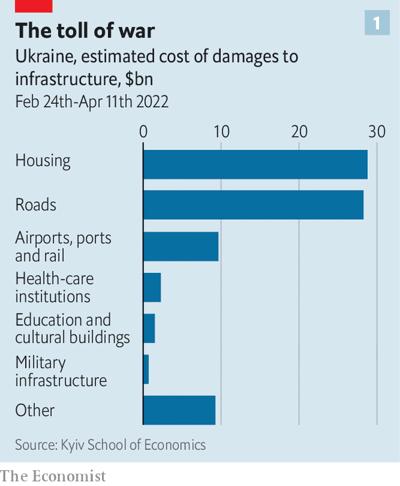
Ukraine will still be able to remain at the top among the largest food exporters, the Ministry of Agrarian Policy and Food of Ukraine states. Even in a pessimistic forecast, 70% of the area will be sown. If Ukraine can demine the huge agricultural areas in Chernihiv and Sumy oblasts in the coming weeks, the sown area may increase to up to 80%, First Deputy Minister of Agrarian Policy and Food of Ukraine Taras Vysotsky stated
Ukraine has normally exported 70% of its agricultural production, leaving 30% for domestic consumption. If Ukraine manage to sow 70% of the areas, and Ukraine take 30-40% for domestic consumption there will also be room for exports. The Deputy Minister emphasised that Ukraine will continue to play an important role in ensuring global food security.
"The most critical factor in exports is the blockade of the ports of Odesa and Mykolaiv because more than 90% of agricultural exports took place before the war through these ports. Other infrastructure is limited. Therefore, if we manage to unblock the ports soon, even following the results of this year, we will be able to remain in the TOP-10 food exporters.”
To ensure food security, NATO need to deploy standing maritime groups to the Black Sea to secure the Sea Lines of Communication. As previously stated:
- On 12 March, NATO’s Allied Maritime Command (MARCOM)issued an urgent warning to ships operating in the Black Sea. The risk of collateral damage or direct hits on Civilian Shipping in the North-Western Black Sea area is considered VERY HIGH,” said There are strong indicators that the intensity of military operations along the Ukrainian Black Sea coastline and in the Gulf of Odesa are increasing. The risk of GPS jamming, AIS spoofing, communications jamming, electronic interference, and cyber-attacks in the area is considered high. Harassment and diversion of shipping in the area cannot be excluded.”
- The last non-Black Sea NATO ship left the Blacks Sea on 2 January 2022.
Legal
“Payback time: The West studies how to make Russia foot the war bill”, Politico reports. “We will restore every house, every street, every city," Zelensky vowed in a video address last month. “You will reimburse us for everything you did against our state, against every Ukrainian, in full." “Wresting that money out of Russia's grasp raises a series of tortuous legal problems. While EU officials are studying whether assets belonging to sanctioned oligarchs — like yachts and oil paintings — could be targeted and channeled to the reconstruction effort, those sums are modest compared with what is needed. Russia's central bank reserves of hundreds of billions abroad are a tempting target, but foreign assets are protected under international law, and confiscating them would require a feat of legal engineering that’s never been successfully pulled off before. Western governments are starting to sketch out ideas from asset seizures to an oil tax to collect the hundreds of billions of dollars required for reconstruction of Ukraine's shattered cities, airfields and factories.”
A list of servicemen belonging to Special Purpose Detachment "Yastreb" of the National Guard of Nizhny Novgorod has been published by Defense Intelligence of Ukraine (DIU) promising to hold them accountable for crimes committed in Ukraine.
Russian mobile crematoria burning bodies of thousands of civilians in Mariupol, Ukrinform reports. Mykhailo Podoliak, an adviser to the head of the Ukrainian President’s Office, wrote this on Twitter. “Russia claimed their goal in Ukraine is to ‘protect people in Donbas’. Right now Russia’s mobile crematoria are burning people’s bodies in Mariupol, the second-largest city in the oblast. Those who survived are dying from starvation. What are you ‘protecting’ them from? From life?” Podoliak wrote.
An online archive of Russian war crimes in Ukraine has been created. The resource was created by the Ministry of Foreign Affairs of Ukraine together with partners. The evidence collected in the archive tells the world the truth about the atrocities of the Russian army in Ukraine. The data on it will be constantly updated in cooperation with Ukrainian law enforcement agencies and international organizations and monitoring missions.
The site documents war crimes committed by the Russian army in Ukraine during the full-scale invasion on February 24, 2022. Crimes are divided into 7 categories: (1) Murder of innocents, (2) Attacks on civilians or civilian objects, (3) Destruction of settlements, (4) Hostages and torture, (5) Illegal deportation, (6) Attacks on religion and culture, and (7) Rape. The site gives visitors insight into the horror of the war, in which Ukrainians have been forced to live since 24 February.
6261 crimes of aggression and war crimes and 2848 crimes against national security were registered as of 13 April. 957 educational establishments are damaged as a result of shelling and bombings, 88 of them are destroyed fully.
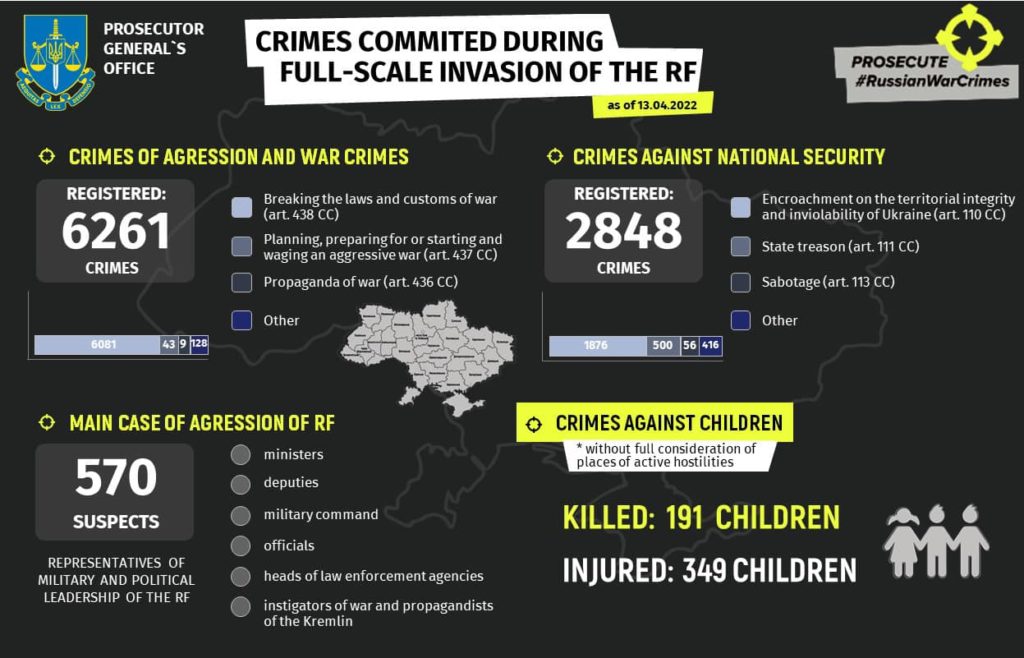
Russian forces search for conscripts in the Zaporizhzhia oblast and forcibly send them to military registration and enlistment offices, Ukrainska Pravda reports. Due to intimidation and pressure on their families, the occupiers are creating detachments of so-called "people's militia" from Ukrainian police.
Support
The US Department of Defense assesses that the Ukrainians still have a majority of their air defense systems available to them, the official said. "The Ukrainians have been clear that they want to boost their inventories for air defense capabilities. They've been clear that they want more aircraft. … We're talking to allies and partners about doing what we can to help them get more long-range air defense systems," the official said.
“Regarding the US-made Switchblade unmanned aerial systems, a significant number of them are now inside Ukraine for use by their forces, the official said. These UAS can carry explosives and have onboard cameras, videos and sensors. The official noted that operating the Switchblade requires only about a day or two of training.
Most of the $800 million in US arms have already been delivered to the Ukrainians, the official said. The Pentagon is also working on another $100 million for Javelin missiles.”
European Union's ports ban Russian ships, Phaata reports. The European Commission (EC) announced that Russian ships and ships operated by Russia are prohibited from accessing European Union (EU) ports. The EC said there would be "certain exemptions" covering essential items, such as agricultural products and food, humanitarian aid and energy.
Of note: The EU decision will have huge consequences for the Russian fishing fleet. Today, they land about 200,000 tonnes of fish in Europe. That is now being stopped. Norway has not yet decided whether it will follow the EU, but in reality, we have no choice, the Norwegian “Fiskeribladet” (The fishing magazine) argues. If Norway does not close the ports to the Russians, Norway will become Russia's safe haven - and all Russian fish may be transported to the world via Norway. This will put Norway in an unacceptable situation.”
Slovakia is weighing whether to send more Soviet-made equipment — in this case, MiG-29 fighter jets — to Ukraine, the Washington Post reports citing Prime Minister Eduard Heger. Slovakia, which shares a 61-mile border with Ukraine, has sent its Soviet-designed S-300 air defense system to Ukraine. However, the NATO member wants to ensure the protection of its own airspace as it moves away from Russian military supplies.
The Pentagon will meet with 8 major military contractors to plan aid for Ukraine, The New York Times reports. A top US defense official said on Tuesday that the Pentagon would convene a classified meeting with the leaders of the 8 biggest American military contractors on Wednesday to discuss stepped-up assistance to Ukraine, including ways to improve air defenses, and anti-ship missiles and weapons to find and destroy Russian artillery.
“Washington’s $1.7 billion in assistance to Ukraine since the start of Russia’s invasion, including the provision of thousands of Stingers and Javelin missiles, has forced American military contractors to step up production of older weapons systems, both for Ukraine’s need and to replenish the United States military’s stocks. The Pentagon is now examining what additional longer-range weapons to supply to Ukraine, as well as making sure that the government in Kyiv receives the basics it needs”.
New Zealand will send more than 50 soldiers to Europe to help distribute aid to Ukraine, a rare move by the government to directly aid a partner during wartime, The New York Times reports. A majority of those soldiers will help transport the enormous amount of military equipment being donated to Ukraine. The rest will support the distribution of humanitarian aid. New Zealand had already sent nine soldiers to aid intelligence efforts in Britain and Belgium. Prime Minister Jacinda Ardern emphasized that soldiers would not enter Ukraine itself.
New developments
- Biden calls Putin’s actions in Ukraine ‘genocide’, CNBC reports. President Joe Biden on Tuesday called Russian President Vladimir Putin’s actions in Ukraine “genocide.” A White House adviser quickly went on TV to clarify that Biden’s words did not reflect a change in US policy towards Ukraine. Biden acknowledged that the legal definition of “genocide” was separate from his impression of what’s going on in Ukraine. On April 5 National Security Adviser Jake Sullivan said that the killings documented so far in Ukraine did not rise to the level of “genocide” as defined by the US government. The State Department has a lengthy internal process for determining if mass killing amounts to genocide, including collecting evidence over a period of time.
US President Biden called the atrocities in Ukraine a 'genocide' for the first time & noted:
"I called it genocide because it's become clearer and clearer that Putin is just trying to wipe out even the idea of being Ukrainian. The evidence is mounting." https://t.co/W4z6qKacnd
— Euromaidan Press (@EuromaidanPress) April 13, 2022
- Putin brushes off sanctions, and says peace talks are at an ‘impasse’, the Washington Post Russian President Vladimir Putin called the war in Ukraine a “tragedy” on Tuesday but insisted that Russia had had “no choice” but to invade. Economic sanctions imposed on his country have “failed,” Putin added, saying that the Russian economy is stable. Putin also said it was unclear when the war would end, stating that the “special military operation” was going as planned and would continue until its goals are fulfilled.
- Ukraine says negotiations with Russia are 'extremely difficult', France24 "Negotiations are extremely difficult. The Russian side adheres to its traditional tactics of public pressure on the negotiation process, including through certain public statements," Ukrainian presidential adviser Mykhailo Podoliak said in written comments to reporters.
- The Presidents of Poland, Estonia, Latvia and Lithuania have traveled to Kyiv to meet President Zelensky.
- Russia, Belarus must enhance integration amid the West’s sanction war, TASS reports citing President Putin. "Among the priority tasks to be coped within the process of building the Union State there are the unification and harmonization of bilateral trade, elimination of administrative and technical barriers and creation of equal opportunities for Russian and Belarusian citizens and business," Putin said.
- Russia has defaulted on its foreign debt, CNN Russia has defaulted on its foreign debt because it offered bondholders payments in rubles, not dollars, credit rating agency S&P has said. “The agency said this amounted to a selective default because investors are unlikely to be able to convert the rubles into dollars equivalent to the original due amounts. According to S&P, a selective default is declared when an entity has defaulted on a specific obligation but not its entire debt. Moscow has a grace period of 30 days from April 4 to make the payments of capital and interest, but S&P said it does not expect it will convert them into dollars given Western sanctions.” The Russian Finance Ministry called the CNN report false, TASS reports.
Assessment
On the War
The Institute for the Study of War has made the following assessment as of Tuesday 12 April:
“Russia continued offensive operations in eastern Ukraine on a limited basis as it worked to reconstitute forces withdrawn from the Battle of Kyiv and to establish necessary logistical bases for increased offensive operations in the Donbas area. Russian forces withdrawn from the Kyiv region have not yet been reintroduced into Ukraine to fight. The Russian military has continued to conduct small-scale limited offensive operations on the Izium and Sievierodonetsk axes and has not yet gone over to a better-resourced or broader offensive campaign. The Battle of Mariupol continues even as Ukrainian officials accuse Russia of using chemical weapons on Mariupol’s defenders.
The Russian military continues efforts to reconstitute forces damaged in the failed attack on Kyiv in the Belgorod and Voronezh areas but has not yet sent those forces back into Ukraine to resume fighting. Ukrainian reports suggest that morale and will to fight remain low in some Russian units and areas. The Ukrainian General Staff reported on April 12 that elements of the Russian 41st Combined Arms Army and the 90th Tank Division are relocating to Belgorod and Voronezh Oblasts.
Key Takeaways
- The Russian military continues offensive operations in Donbas and is not in a pure reconstitution phase. It has not undertaken an across-the-board operational pause while waiting for reinforcements to arrive. In part, as a result, it has made limited gains while continuing to sustain significant losses.
- Mariupol has not yet fallen.“
The enemy is planning terrorist attacks on its territory to inject anti-Ukrainian hysteria, DIU claims. "Russian special services are planning a series of terrorist attacks to blow up and blow-up residential buildings, hospitals, and schools in Russian settlements. As well as the launch of missile and bomb strikes on the city of Belgorod or one of the cities of Crimea," claims the head of the Defense Intelligence of Ukraine, Major General Kirill Budanov.
“He is convinced that the failure of Russia's mobilization plan is forcing the Putin regime to use dirty scenarios to emotionally stir up Russian society and consolidate it even more against Ukrainians. Ukraine and volunteer battalions to create an emotional picture of the "atrocities of Ukrainian nationalists. It is quite possible that these terrorist attacks will be presented as a revenge of Ukrainians for Bucha and Kramatorsk and as a justification of cruelty against the Ukrainian civilian population, the head of the GUR emphasized.
In recent days, the Russian government has been increasingly dispersing the flywheel of anti-Ukrainian hysteria. Trenches are being actively dug in Belgorod and Kursk oblasts, and panic is flaring up over the imaginary offensive of Ukrainian volunteer battalions and sabotage groups, Budanov added. In his opinion, it is very symbolic that Putin's rule began with terrorist attacks against Russian apartment buildings, which became the basis for the destruction of Chechnya. And now, it seems, it ends with the same methods.”
Ukraine braces for a new offensive as Russia reinforces its military in the east, the Washington Post
reports.
“… the Pentagon on Monday said there are signs that the Kremlin has begun reinforcing and resupplying its forces in the eastern Donbas region as a top official in Moscow vowed there would be no letup in hostilities before the next round of peace talks.
US intelligence has observed a massive Russian military convoy making its way south toward Izium, a strategically important town in northeast Ukraine that Russia seized earlier this month and may use now as a staging point to carry out assaults on larger cities to the south, said Pentagon spokesman John Kirby. The expectation, Kirby added, is that the “same brutal tactics, that same disregard for civilian life and civilian infrastructure, will probably continue” as Russian military commanders concentrate on the Donbas.”
Consequences and what to do?
Yesterday the Washington Post columnist Max Boot wrote a great piece offering an explanation as to why “Russia keeps losing wars because of its dysfunctional military culture”.
The war is far from over, but Ukraine’s triumph over Russian forces in the Battle of Kyiv was an epic victory for the ages. … How did the Ukrainians succeed in driving off the mighty Russian army, which was widely expected to march into Kyiv within a few days?
Much attention has been paid, and understandably so, to the high-tech weapons systems supplied by the West, such as the Stinger antiaircraft missile and the Javelin antitank missile. But the Russians have high-tech weapons, too. The Ukrainians’ real advantage lies in the realm of military culture — which, of course, is a reflection of society writ large.
All of the Russian military’s manifold deficiencies have been brutally exposed during its unprovoked invasion of Ukraine. These include corruption, brutality, low morale, poor planning, faulty logistics, bad intelligence, lack of coordination between units, over-centralization and a paucity of initiative on the part of junior officers and sergeants. These are not new problems, and they will not be fixed any time soon. Indeed, an 1854 article in the Economist explaining Russia’s early defeats in the Crimean War — also fought primarily in Ukraine — reads eerily like an account of Russia’s current military travails…
Two of the Russian weaknesses identified by the Economist particularly leap out. First: “The Russian armies are often armies on paper only. … The colonels of regiments and officers of the commissariat have a direct interest in having as large a number on the books and as small a number in the field as possible — inasmuch as they pocket the pay and rations of the difference between these figures.” Second: “Common soldiers … have no love of their profession, and no interest in the object of the war.” That was because the typical Russian private was “torn from his family and his land, drilled by the knout, neglected by his officers, fed on black bread, where fed at all, always without comforts, often without shoes.”
The Economist ascribed these pathologies to the “inadequacy of despotic power.” It noted that “cheating, bribery, peculation pervade the whole tribe of officials,” that “there seems to be no conscience, and not much concealment, about it,” and that “regard for truth or integrity has no part in the Russian character.”
…Russia is still ruled, as it has been throughout nearly all of its history, by a brutal and corrupt dictatorship.
The shortcomings of public administration help to explain Russia’s dismal performance in conflict after conflict. Russia lost not only the Crimean War (1853-1856) but also the Russo-Japanese War (1904-1905), World War I (1914-1918), the war in Afghanistan (1979-1989) and the First Chechen War (1994-1996). Its major military victories — in the Napoleonic Wars and World War II — came only after an invader was foolish enough to dissipate his forces in the vast Russian landscape and only when Russia was greatly assisted by Western allies.
The Ukrainian army, an outgrowth of the Red Army, was initially hobbled by many of the same difficulties as the Russians, but after 2014, the Ukrainian military and state reformed themselves along Western, democratic lines. As Politico notes, the training Ukrainians received from Western soldiers and their own experience fighting Russian-backed separatists in the east overturned “the old Soviet model of top-down leadership that has paralyzed Russian units” and “spawned a new generation of small-unit leaders and noncommissioned officers who can think and act independently.”
The Financial Times’s Tim Judah offers a telling example of Ukrainian ingenuity and initiative in the Battle of Kyiv. He describes how “Moscow’s forces were thwarted … by pieces of foam mat … costing as little as one and a half British pounds. The mats prevent Russian thermal imaging drones from detecting human heat. ‘We held the mats over our head,’ said battalion commander Oleksandr Konoko, explaining how his men moved stealthily in tiny groups at night. In that way, soldiers armed with anti-tank weapons supplied by the US, Britain and others could sneak up on the Russians, fire their deadly and accurate missiles and then slip away.”
The Russians may eventually be able to assemble fresh forces to fight in the Donbas region — although it will take some time — but they will not be able to change their stultifying military culture. That is why I expect the Ukrainians to continue winning the war, providing they continue to receive the weapons and ammunition they need from the West. A superior military culture is Ukraine’s secret weapon.
Assessment by Hans Petter Midttun
The article helps substantiate and expand the conclusions Andriy Zagorodnyuk, Alina Frolova, Oleksii Pavliuchyk, and myself made in the analysis “Is Ukraine’s reformed military ready to repel a new Russian invasion?”.
So far, the answer has been a resounding yes. A combination of reform, modernization and experience and knowledge gained, combined with great intelligence, an amazing grip on information operations, a resilient Ukrainian society, a volunteer movement unparallel to anything we may have ever seen in Europe, an impressive and unprecedented Western support and not at least, a long list of Russian failures, have helped Ukraine both survive and inflict Russia tremendous damage.
The war, however, does not stop today. Russia is upholding its ambition to defeat Ukraine. Its campaign plan has changed. The timeline looks different today than on 24 February. The strategic aim remains the same.
As we watch Belarus being closer integrated into the “the Union State” only to slowly become an integrated part of the Russian Federation, we need to recognize that this is the faith that awaits Ukraine if it fails in the next phase of the war. The difference is that unspeakable atrocities and destructions will lay the foundation for a “Ukrainian integration”.
The question we need to ask ourselves after having witnessed a genocide taking place, is: Do we truly do what is within our power to do to stop it from happening?
If we cannot provide Ukraine with advanced, hi-tech weapon systems because its Armed Forces are unable to operate them, then NATO needs to operate the advanced, hi-tech weapon systems that Ukraine needs.
This takes me back to the aforementioned article published in December 2021: “A strong Ukrainian Armed Forces is a safeguard against the major war that is emerging on Europe’s eastern borders. Therefore, the support of our partners is not an issue of compassion, but a matter of being able to gain time to strengthen their own defenses.”
It is time for a “change in guards” and for the partners to step forward and do more.

